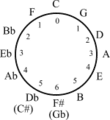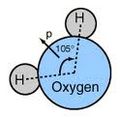Group theory facts for kids
In mathematics and abstract algebra, group theory studies a type of algebraic structure called a group. Group theory is often used in mathematics as a starting point for the study of many algebraic structures, such as a set of numbers along with its addition and multiplication. Because group theory is also useful for studying symmetry in nature and abstract systems, it has many applications in physics and chemistry.
Definition
A group is a set (collection) G whose members are called elements. The elements can be numbers of some kind, or other abstract objects. The elements can even be material objects. There is also a binary operation which combines any two elements of G and results in another element of G. This new element may be different from either of the original two, but it does not have to be: it only has to be an element of G. To be a group, the following four conditions must be true of G and the operation defined over G:
- Closure: It is required to check if the suggested operation is actually an operation on the set. If an operation is used on any elements in the group, the element that is formed will also be part of the group.
- For all a, b in G, the result of the operation a • b is also in G.
- Identity element: One element of the group is special. It is called the identity element, often written as e. If the operation is used with the identity element and another element, the other element will not change.
- There exists an element e in G, such that for all elements a in G, the equation e • a = a • e = a holds.
- Associativity: When there are many operations, it does not matter in what order they are done, the result will be the same.
- For all a, b and c in G, the equation (a • b) • c = a • (b • c) holds.
- Inverse element: Every element in the group has another element in the group known as its inverse. When the operation is performed between them, the result is the identity element.
- For each a in G, there exists an element b in G such that a • b = b • a = e, where e is the identity element.
An important fact about groups is that when two elements are combined using the operation, the order of the elements matters. Switching the order of two combined elements typically gives a different result. This means that we have many cases with a • b ≠ b • a.
However, if the order of a and b actually does not matter (for any a and b, we always have a • b = b • a), then the group is called an abelian group (or commutative group).
If a group contains finitely many elements, then it is called a finite group. If a subset of a group is also a group, then the subset is called a subgroup.
Examples
A simple example of a group is the set of integers (called Z) with the addition operator +. This group is called G = (Z, +). Each of the required conditions is true of G, so G is a group. If we replace • with the + sign, then we can easily check that these conditions are true:
- Closure: For any two integers a and b in G, a + b is also in G. For example, 3 and 5 are integers; and if we add them together, we see that 8 is an integer too.
- Identity element: For any integer a in G, a + 0 = a. So 0 is the identity element of G. For example, 69+0 is still 69.
- Associativity: For any three integers a, b, and c in G, (a + b) + c = a + (b + c). For example, (1+3)+7 is the same as 1+(3+7).
- Inverse element: For any integer a in G, there is another integer b = −a in G such that a + b = 0. For example, 4 + (−4) = 0. In other words, −4 is the inverse element of 4.
The addition operator is also commutative: the order of a and b does not matter. For any two integers a and b in G, a + b = b + a. For example, 7+3 is the same as 3+7. Thus, G is also an abelian group.
Commutative operators are common in our daily lives. For example, 7 · 3 is also the same as 3 · 7. However, not all operations are commutative. For example, 7÷3 is different from 3÷7 (and neither of these results is an integer), and 73 is different from 37. Therefore, not all combinations of number sets and mathematical operations can form an abelian group—or even a group at all.
Related pages
Images for kids
See also
 In Spanish: Teoría de grupos para niños
In Spanish: Teoría de grupos para niños




